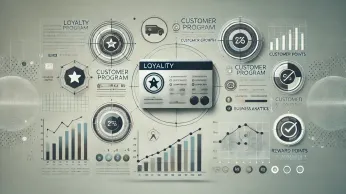Best Rewards Programs: How to Build a Rewarding Journey with Case Studies & Real-Life Application
The best rewards programs make customers feel valued and appreciated when they are rewarded for their loyalty. Learn to make a rewarding journey for your consumers.
On this page
Ulta Beauty, a successful American chain of beauty stores, is known to many for its strong online presence and services such as a loyalty program, free shipping on purchases over $35, and a generous return policy. However, what many don't know about is the impact of Ultamate Rewards program on customers. Currently, it boasts a continuously growing membership base exceeding 40 million. What's more shocking is that 95% of Ulta Beauty's sales are tied to its best rewards program.
In an interview, Karen Bernhardt, Ulta Beauty's Chief Marketing Officer, highlighted the significance of the Ultamate Rewards program. The inclusion of the reward program not only tracked the evolving consumer trends but also fostered meaningful customer engagement. As a result, Ulta Beauty consistently delivered value and personalized experiences across various customer touchpoints, including product discovery, checkout processes, and promotions.
Understanding that rewards are an important factor in running a loyalty program, Bernhardt utilized what was needed to derive value and evolve. In fact, a report has shown that 52% of American consumers will join the loyalty program of the brand they make frequent purchases from.
It goes on to show the significance of a loyalty program and how it can turn your customers into fans. Therefore, knowing the significance of the rewards programs, we will share how you can create the best rewards programs that will drive results.
What is a rewards program?
A rewards program is a system offered by businesses to their customers. The best rewards program incentivizes customers to make repeat purchases or engage with the business in other ways by offering them rewards, such as discounts or free products.
So, in essence, it is a way for businesses to thank their loyal customers and encourage them to continue doing business with them. A study found that 50% of consumers join loyalty programs because they want to receive rewards for their regular purchases. Evidently, the best reward programs go beyond customer appreciation and motivating consumer behavior, however, if implemented well, the benefits include,
- Improve revenue and retention,
- Stronger customer relationships,
- Differentiating a brand from competitors,
- Encouraging word-of-mouth marketing,
- Enhanced customer loyalty, and positive brand image.
Let us quantify the benefits of reward programs.
- A study indicates that 29%, of customers find current reward offerings to be lacking in excitement.
- Another report has revealed that 87% of consumers are receptive to brands monitoring their activity details if it leads to the personalization of reward programs. It showcases the consumer's desire to receive personalized rewards.
- A Forbes study showed that 79% of Americans are more inclined to participate in rewards programs that do not necessitate carrying a physical card.
- The same study indicates that 46% of customers find gifts and promotional merchandise (swag) desirable benefits that loyalty programs offer.
- 44% of recipients of the reward program say they receive a thank you upon redeeming their rewards.
Now that we have understood the essence of the best rewards programs, let’s learn the types of reward programs that can be implemented into your business along with examples.
Types of rewards programs
Rewards programs are a way for businesses to encourage customer loyalty by offering benefits for repeated purchases or engagement. Here are some common types:
1. Points-based programs
In this type of program, customers earn points for their purchases, which they can later redeem for rewards.
2. Tiered programs
These programs offer different levels of benefits based on customer spending or engagement. Higher tiers may unlock exclusive rewards, discounts, or priority customer service.
Members can earn Medallion Qualification Dollars (MQDs) to qualify for different status levels, with higher tiers receiving additional perks like priority security lane access, choice benefits, and exclusive savings on Delta Vacations.
3. Cashback programs
In cashback programs, customers receive a percentage of their purchase value back as cash or credits. Customers earn a percentage of their purchase amount back in cash, which can be credited to their account or redeemed as a statement credit.
4. Subscription programs
These programs typically involve a recurring fee in exchange for ongoing benefits or discounts. Customers pay a recurring fee to receive regular deliveries of products, access to exclusive content or services, or discounted prices.
The subscription includes regular software updates, access to premium features on mobile devices, and Adobe Document Cloud services and offers flexible payment options, with the option to pay monthly or annually. One can choose to purchase individual applications or the entire suite of applications.
5. Value-based programs
In these programs, rewards are based on the value of the customer's transactions rather than a set point or cashback system. These programs go beyond simple transactions and reward customers for actions that demonstrate brand loyalty or engagement. This could include social media interaction, attending events, or providing feedback.
Now that we have gone through the types of reward programs that are there, let us know how companies implement the variations to rise to the top.
Case studies
Following are the examples of case studies by companies that ran the two best rewards programs for increased awareness, and boosted loyalty.
1. Abercrombie & Fitch reports 13% future purchase intention by running myAbecrombie
The clothing store Abercrombie & Fitch, headquartered in Ohio, is known for its stylish clothes and its successful rewards program, myAbercrombie. This program provides shoppers with several benefits, including discounts, special offers, exclusive deals for members, and free shipping on orders over $150. To make it a huge success, they included three two types of reward programs:
- Tier-based reward program,
- Point-based reward program.
Let's dive deep into understanding how Abercrombie won their customers over.
myAbercrombie: A rewarding approach towards customer appreciation
The myAbercrombie rewards program by Abercrombie & Fitch offers customers benefits when they join. Customers sign up for free by participating at U.S. Abercrombie or Kids stores, online at Abercrombie.com, or by downloading the app and providing their name, phone number, and email address. they not only provided their customers with multiple touchpoints to shop but also gained useful data to leverage for personalization.
Upon joining, members receive a welcome offer and are assigned a digital myAbercrombie ID, accessible through the app or online. Now, this ID plays a crucial role:
- This ID is used to earn points for purchases.
- Members without the app can share their registration details with an associate to link their ID to their purchases. So, it helps them track their purchase that can be personalized.
Apart from ID, Abercrombie gives members exclusive perks such as:
- Special pricing,
- Member-only discounts,
- Exclusive offers,
- Early access to sales.
There is an inclusion of tier-based and point-based reward systems as well which prompts the customers to shop more.
- Points are earned based on purchases, with all members receiving ten myAbercrombie points per $1 spent,
- While VIP members earn 15 points per $1 spent.
- Once a member accumulates 2,500 points, they receive a $10 reward.
Members can track their points and membership details in the app or online account. Points typically reflect within 48 hours of purchase but may take longer in some cases. Points do not expire as long as at least one eligible purchase is made within a year.
Rewards can be redeemed in $10, $20, $30, or $40 denominations, depending on the points earned. They can be used in-store or online, with rewards expiring after 90 days. Members can use up to three rewards in a single transaction.
Impact of myAbercrombie
The extensive and well-thought rewards program has yielded a result significant for Abercrombie & Fitch.
- A survey in the United States indicates that approximately 13% express a likelihood of returning to Abercrombie & Fitch.
- 13% of customers report a future purchase intention
- The existing customer base demonstrates a 15% usage rate.
- This statistic can be viewed in the context of the brand's current 15% share of customer usage.
2. Kantar distributed more than 3.32 million USD in rewards using reward automation
Kantar is a globally recognized leader in data analysis, consumer insights, and consulting services. With a presence in 90 countries, Kantar offers a comprehensive understanding of consumer behavior around the world. Kantar collaborates with clients to develop strategies for various goals, such as enhancing brand recognition, attracting new customers, expanding brand presence, achieving financial objectives, or boosting public trust in government services. However, Kantar was facing an issue with rewarding its clients.
Challenges kantar faced
Before adopting Xoxoday, managing panel rewards was a laborious task for Kantar. It involved manual procurement and distribution of incentives. This process presented logistical and operational hurdles. The shift to remote work only added to the complication and made the use of physical rewards an issue.
Moreover, the substantial increase in online surveys necessitated a more streamlined and automated system for incentivizing participants. The previous solution they used proved to be inefficient. It not only consumed a significant amount of employee time but could not effectively analyze and report on reward redemption patterns.
Solutions provided by Xoxoday
Xoxoday automated the reward distribution process to make faster turnaround times and increase redemption rates. It integrated a centralized dashboard to manage incentives and rewards for respondents. To ensure a smooth experience, Kantar was assigned a dedicated customer support team and an account manager. This team assisted with setup, onboarding, and ongoing support.
This solution empowered Kantar to offer instant rewards upon survey completion. After finishing a survey, panelists would automatically receive a voucher redeemable for over 21,000 reward options across 100+ countries. This not only eliminated the operational burden of reward distribution but also ensured compliance with data privacy regulations.
Xoxoday freed up researchers' and business teams' time by handling the procurement and distribution of rewards. This allowed them to focus on core tasks. The solution enabled Kantar to adapt to the post-pandemic environment and provide instant rewards to online participants.
Results
Xoxoday offered Kantar a system for immediate reward delivery.
- Kantar sent encrypted voucher links directly to participants through email and SMS. Participants have a vast selection of over 21,000 international experiences, gift vouchers, and products to choose from.
- Kantar has distributed more than 3.32 million USD in rewards through Xoxoday in the past three months.
How to implement the best rewards program?
Here's a more comprehensive approach to implementing a successful rewards program:
1. Craft a distinctive and memorable name
The program's title should be clear, catchy, and easily recalled by customers. Think beyond descriptive titles and consider names that evoke positive emotions or create a sense of exclusivity.
2. Prioritize customer engagement
Design the program to actively involve customers and keep them interested. This could involve offering points for various actions beyond purchases, such as attending workshops, participating in surveys, or following the brand on social media.
3. Offer valuable and meaningful benefits
Rewards should be desirable and relevant to your target audience. Conduct surveys or market research to understand what motivates your customers. This could include exclusive discounts, early access to new products, personalized recommendations, or unique experiences.
4. Incorporate customization and flexibility
Allow some degree of tailoring the program to individual customer preferences. This might involve offering a choice of reward categories or enabling customers to accelerate their progress toward specific goals. A program that feels personalized fosters a stronger connection with the brand.
5. Maintain ethical practices
Ensure the program operates fairly and transparently, respecting customer privacy. Clearly communicate the program's rules, points expiration policies, and how customer data is used. Building trust is essential for long-term customer loyalty.
6. Consider tiered systems
Offer increasing rewards based on a customer's level of engagement or spending. Tiered structures incentivize continued participation and can create a sense of accomplishment as customers progress through the levels.
7. Align with your mission
The program should complement your company's overall values and goals. Does your brand prioritize sustainability? Offer rewards that promote eco-friendly practices. Is your company known for exceptional customer service? Integrate rewards that recognize customer referrals or positive reviews. A cohesive program strengthens your brand identity.
Rewarding the participants for taking the survey is an important part of acquiring data. Xoxoday not only streamlined the process of rewarding using their significant service, but ensured efficient delivery, and flexibility.
8. Strive for simplicity and transparency
Make the program's rules and benefits easy for customers to understand. Provide clear communication through multiple channels, such as your website, social media, and in-store signage. Customers shouldn't have to jump through hoops to reap the rewards.
9. Track and analyze data
Monitor program performance to ensure it meets objectives and identify areas for improvement. Track metrics like customer participation, redemption rates, and overall program sentiment. Use this data to refine your program and maximize its effectiveness.
Conclusion
With satisfied customers more likely to keep coming back to earn rewards from their favorite brand, it becomes imperative to place the best rewards program to encourage repeat business. So, your search for the best reward marketplace ends here. Businesses can strengthen their customer loyalty programs through the Giift marketplace. This platform offers a user-friendly experience with a wide variety of rewards, along with:
- A diverse selection of physical and digital reward options across various categories. With over 10 million reward options spanning 30+ categories, businesses can leverage the marketplace.
- Coverage in over 100 countries allows businesses to engage and retain global audiences through rewards that cater to different regions and cultures.
- Ability to white label the marketplace with their logo and brand colors.
Giift marketplace can be integrated into existing systems. So, make reward management and its delivery efficient and hassle-free for your business and ensure security and compliance.








